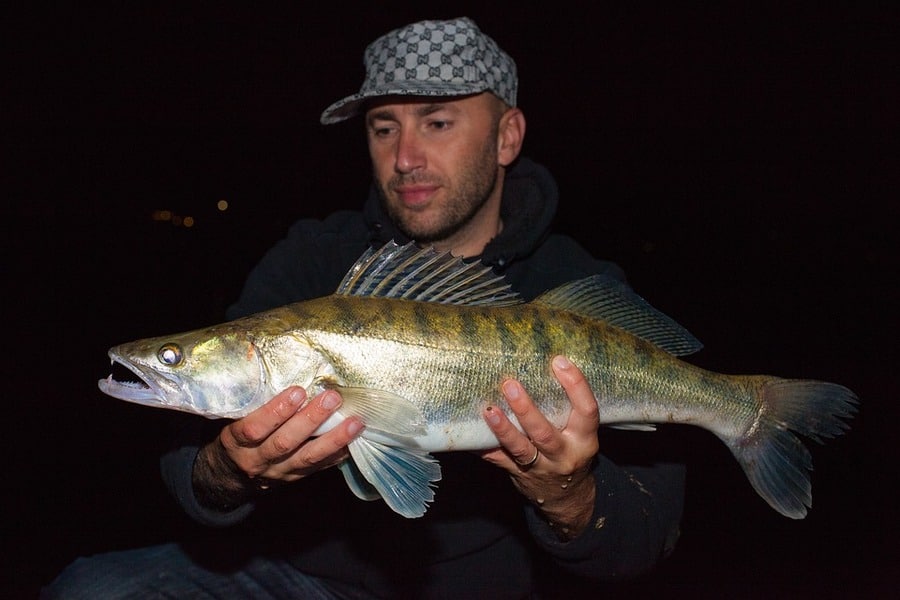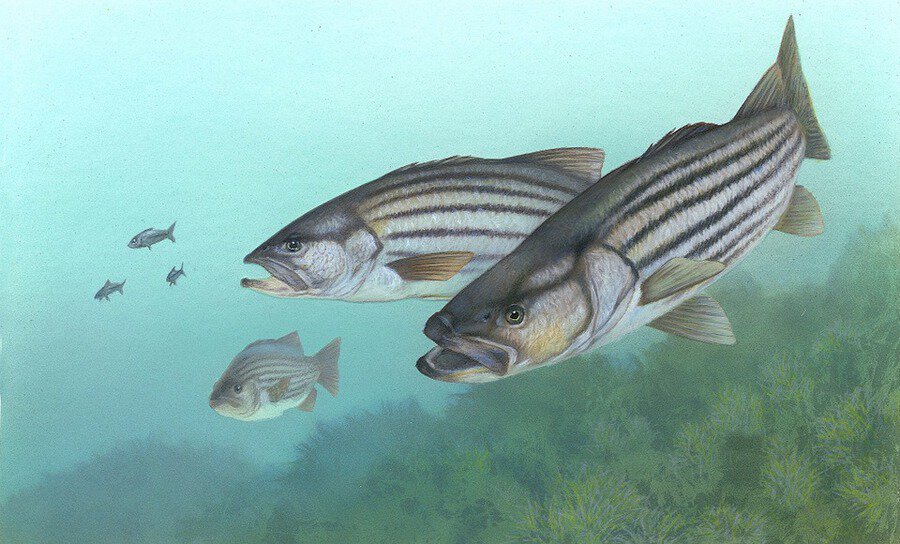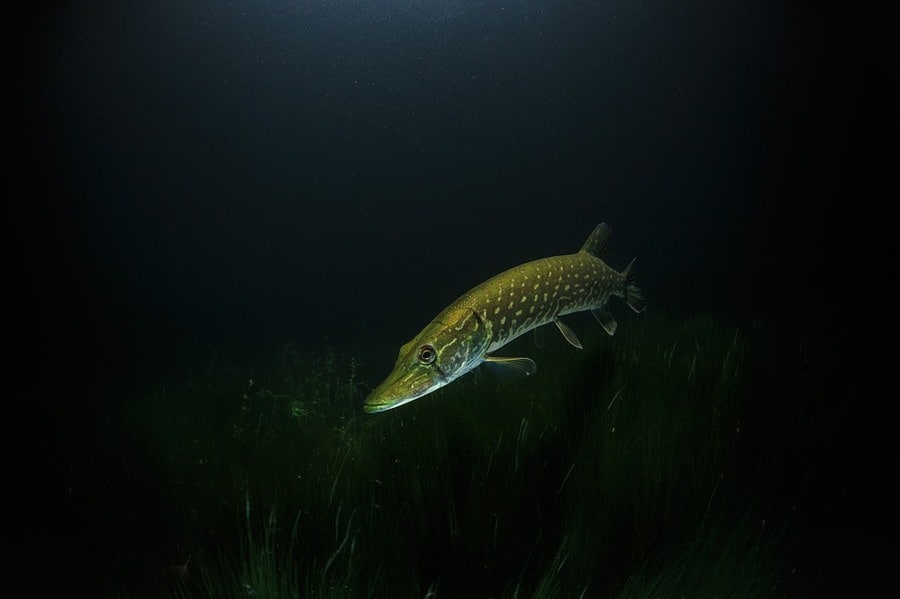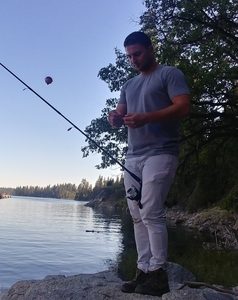What Freshwater Fish Bite at Night? A Helpful Resource

Leave a comment after this article and let’s talk more about walleye fishing. I’d love to read your feedback.
The idea of fishing at night gives many new and intermediate anglers hesitation. Not only is nighttime fishing a foreign concept to many fishermen, but they also don’t know which species of fish to go after. Many fish bite very well at night as long as you know where to locate them.
What fish can you catch at night? Most nights, you can catch catfish, carp, and walleye whereas fish that rely on sight like pike, bass, trout, and yellow perch are caught primarily on full moon nights.
Striped bass, though a vision-guided fish, are very light-shy and best fished for on dark nights with limited overhead moonlight. These are just general guidelines and not set in stone as some fish can go against their own normal ways and feed when you wouldn’t expect.
In this article, we will cover what factors affect nighttime fishing like the season, temperature, and moon phase. We will also give you a general overview of each fish species and how they react to nighttime in terms of feeding activity.
I know this is a bit random, but if you ever wanted to go on a guided or chartered fishing trip in freshwater or saltwater, you should check out Fishing Booker. They are the leading database of certified and professional fishing guides at the guaranteed lowest prices.
They have countless listings for such dream destinations as the Florida Keys, Corpus Christi, Great Lakes, San Diego, Central America, Montana, and many more. Click here to visit Fishing Booker and book your trip of a lifetime at very affordable prices.
To learn how to catch fish at night, please check out this helpful article I wrote detailing which fish bite best at night.
What Fish Can You Catch at Night
Is Fishing Good at Night
Fishing can be really good at night but it depends on the season, air temperature, moon phase, and species of fish targeted.
Smell-focused predators like carp and catfish do very well at night as they don’t need to see to find food. There are plenty of fish that rely heavily on sight to find food who are handcuffed by the darkness of most nights.
These are only active on nights with the fullest of moons. We will go through each of these fish in the next section. Make sure you read each one thoroughly before heading out onto the water.
Night Bite: Catfish
Most fishermen think catfish angling is best at night and during the summer, this can certainly be the case. Catfish rely on their senses of touch and smell to locate food so they can find food at night in the dark when most fish cannot.
That said, during the winter, do not waste your time trying to fish for nighttime catfish. Catfish will be seeking out the warmest water possible during the winter and will wait until the midday sun warms up the water before aggressively feeding.
During the summer, catfish seem to prefer hunting on really dark nights. For some reason, they don’t feed as aggressively on full moon nights. At least this has been my experience and I’ve read from other fishermen with similar opinions.
Night Bite: Bass (Largemouth & Smallmouth)
Nighttime bass fishing can be very hit or miss. Bass rely on their sight to find and close-with prey. On most nights, bass tend to hunker down as they cannot see well enough to search for prey. They would be wasting a lot of energy hunting at night when they have a slim chance of locating food. They would also run the risk of swimming into a big catfish or musky if they weren’t careful.
Big bass can be caught at night but you need to be very precise with your bait placement. Bass won’t move to feed at night.
They will only feed on food right by their face. It will take you a lot of casting and trials before you hook into a good bass at night. That said, on full moon nights, bass can be very active feeding in the top 6 feet of water.
Night Bite: Striped Bass

Striped bass bite day and night but during the early summer when shad and alewives are spawning, there is no better time for hard-hitting topwater striped bass action.
In late May into June, striped bass starting keying in on shad and alewives who spawn at the surface night after night. Big striped bass love this time of year and feed very aggressively on these fish.
To locate the bass, just listen. On quiet nights, you can hear the explosion of striped bass strikes on the surface from across the lake.
Striped bass prefer very dark nights as they are light shy. They will feed much further down the water column on nights with a full moon. If you happen to turn on artificial light, the striped bass may stop feeding altogether or move far away from your source of light.
Night Bite: Carp
Carp pretty much feed day and night during the warmer months. It’s hard to say one time of day is better than the others.
You can catch carp feeding on the bottom in the morning, basking near the surface midday, gobbling up insects near sunset, and feeding in the mud at night. I personally feel like any time of the day, carp can be caught.
That said, don’t fish for carp at night during the winter. This would be a big waste of time as carp will be very active during the warm parts of the day but go relatively dormant during the cold of the night.
Night Bite: Bluegills
Bluegills, for the most part, don’t feed much at night. Their vision is more limited than that of a bass in the dark. It becomes very hard for them to spot prey even on full moon nights. Furthermore, bluegills cannot detect approaching bass, walleye, pike, and catfish that want to eat them.
On most nights, bluegills will hold tight to cover and rarely venture out of the safety zone. If they do, not only will they have a hard finding food, there could be big fish out there waiting for them.
Night Bite: Yellow Perch
Yellow perch can be caught at night under full moon conditions. Yellow perch are pretty vision-dependent when it comes to finding food and avoiding predators. While they can find food on dark nights, their eyes help them find more food on well-lit nights with a full moon overhead.
Yellow perch, because of their small size and tasty meat, are prime food for catfish and walleye who both feed extensively at night. If you want to catch yellow perch at night, I recommend you focus on fishing around sunrise or sunset and only on full moon nights.
Night Bite: Trout
Trout usually prefer feeding during the daytime when they can use their sharp vision to detect prey and avoid being eaten themselves. While trout feed all day long, they really amp up feeding at sunrise and sunset.
Occasionally, you can catch trout at night but action slows down after dark. Focus on well-lit full moon nights when trout have the best chance of seeing your lure presentation.
Night Bite: Walleye
Walleye are vision-oriented predators but they have specially designed eyes that allow them to absorb even the smallest amount of available light from the water. Walleye routinely feed throughout the night where their superior night vision is better than any prey source they feed on.
During the day, walleye are often found in deep water far from shore chasing schools of shad. As the night rolls in, walleye head into shallower water after yellow perch, bluegills, shiners, and shad that are hunkering in for the night. To catch nighttime walleye, head for shallower water.
To learn how to catch walleye at night and what the best time of day to catch walleye is, check out this article I wrote on the topic. This article will teach you when to be on the water and where to pattern walleyes after dark.
Night Bite: Pike
Northern pike rely heavily on their vision to detect prey. You can occasionally get pike to strike at night but certain criteria need to be met.
For much more information on catching pike at night, check out the article I wrote on the topic. This thing is jam-packed with helpful tips to pattern and catch nighttime pike.
To learn which baits to use, check out my recommended gear lists for carp, bluegill, crappie, yellow perch, and northern pike.
A great castable fish finder can be an awesome tool for locating fish and fishable spots from the bank, boat, or through the ice at night or during the day. I like the Deeper PRO+.

Moon Influence on which Fish Bite at Night
The moon plays a huge role in the feeding behavior of various fish species at night. Catfish and carp do really well finding food at night. In fact, catfish seem to prefer dark nights on the with very little moonlight.
The same is true of striped bass as they prefer as little overhead moonlight as possible. Walleye have very good night vision so they seem largely unaffected by the moon phase.
As for fish that rely heavily on their vision to find food, the moon is essential to their activity. Largemouth bass, yellow perch, pike, and trout need the moonlight to find food.
Most of the month, these fish do not feed much at night and will only attack prey that swims right to them since they can’t see well enough to search for their own food. However, on full moon nights, enough light can penetrate the water to allow these vision-based fish to search for food near the surface.
What Fish Bite Best at Sunrise & Sunset
There are a variety of fish species that bite best around dawn and dusk. Catfish and Carp bite all day as well as throughout the night but the best time of day to fish for them seems to be at sunrise and especially sunset.
This is especially true of catfish as their bite really heats up near sunset. Bass, yellow perch, and pike bite the best at sunrise and sunset because their specially designed eyes allow them to see in these reduced, but not dark, light conditions better than most of the prey they hunt.
Bass, in particular, will launch aggressive attacks on prey like bluegills, frogs, shad, and shiners who oftentimes cannot see the bass coming. Trout also seem to really do well feeding near sunrise and sunset. Many fly fishermen do really well first thing in the morning.
Daytime vs. Nighttime Fishing
Many freshwater fish bite better during daytime hours when there is ample sunlight water penetration for them to see and attack prey. Fish like bass, perch, bluegills, pike, and trout which are reliant heavily on sight, seem to bite best during the day.
Often times these fish feed most aggressively at dawn and dusk because their specialized vision allows them to see better in these transitional light periods than the prey they hunt.
This is especially true or bass and pike. Water temperature also plays a huge role too. During the hottest parts of the day, fish will be more docile or seeking out the coldest water they can find.

At sunrise and sunset, the water temperature is ideal. I would strongly recommend some type of water thermometer that can tell you water temps at various depths.
I really like this water thermometer system as it will accurately tell you water temps down to 300 feet. This will be a very handy tool for locating proper water temps for catfish, bass, pike, and especially trout.
Nighttime fishing can be very food for catfish and carp which don’t rely heavily on their vision to find food. Walleye are another big time nighttime hunter.
They have specially designed eyes that allow them to see much better at night than shad, shiners, perch, and other fish they are trying to eat. Bass and pike fishing can be good at night as long as there is a full moon to provide enough light.
Summer Nighttime Fishing
Night fishing can very hit or miss during the summer for a variety of species of fish. Carp, catfish, and bullheads can become very active feeding at night as water temperatures cool down.
Their senses allow them to locate food in the dark other sight-driven fish cannot. Sight-based predators like trout, bass, bluegills, and pike are typically less aggressive feeders at night since their vision is limited. They can only strike prey that comes right to them.
On full moons when there is a bright sky overhead, these fish can come alive feeding in the upper 3-6 feet of water where the moonlight penetrates enough to illuminate food.
Water temperature and available light sources are primary drivers of many fish during the summer at night. Water temperatures cool way down at night prompting many fish to feed as long as there is enough moonlight to help them find prey.
Winter Nighttime Fishing
Nighttime fishing can be much tougher during the winter in many parts of the country. In southern states that enjoy fairly mild winters, night fishing can be good for catfish and carp, as well as bass and panfish on well-moonlit nights.
In colder states, nights can be downright brutal. Many fish up north including catfish, trout, bass, and crappie are most active feeding when water temperatures are at their daily peak.
This typically occurs during the day. At night when what is coldest, most fish will become docile and wait until water temps rise up before resuming hunting. That said, yellow perch and walleye fishing can be very good during the winter at night.
Related Questions
Do Artificial Lights Help Night Fishing?
Artificial lights can be helpful and sometimes hurt night fishing. Many fish are curious and subsequently attracted by light at night.
Light also draws in insects that can give fish food to eat but can draw in mosquitoes too you’ll have to contend with. Striped bass, on the other hand, do not respond well to artificial light as they prefer black-out conditions at night.
The big thing artificial light offers fishermen is safety and the ability to see what they are doing so for that, I will say that night fishing is improved by using artificial lights.
Is Night Fishing Dangerous?
Fishing at night can be more dangerous than fishing during the daytime. Everything seemingly gets more complicated in the dark. Artificial lights limit your vision to only a small area of view meaning your peripheral views are gone.
There are many ways to make nighttime fishing safer including arriving at your fishing spot before sunset, ensuring you are wearing a life vest, and using a lantern to illuminate the boat. This is a great lantern used by many boat fishermen and campers.
